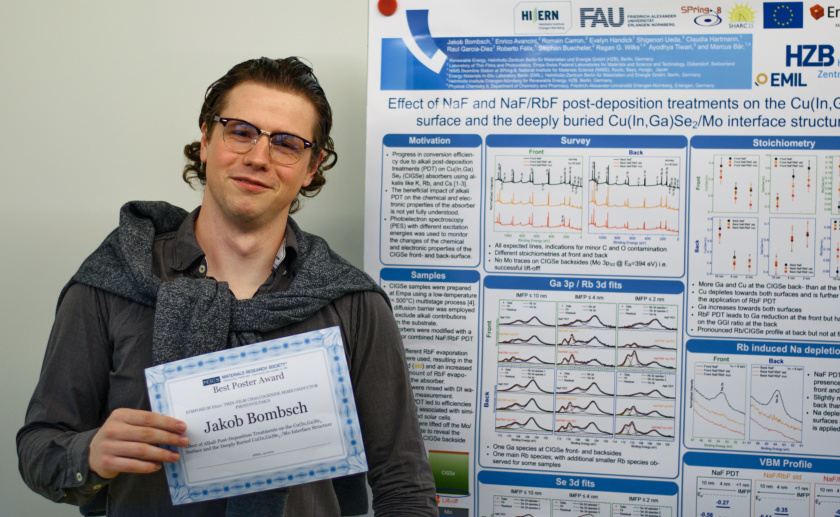HZB-Doktorand receives poster award

Jakob Bombsch received an award for his poster on CIGSe absorbers at the spring meeting of the Materials Research Society. © Privat
At the spring meeting of the Materials Research Society, Jakob Bombsch received an award for his poster on CIGSe absorbers for thin-film photovoltaics. Bombsch is a researcher in the department for Interface Design headed by Prof. Marcus Bär.
In his doctoral thesis, Jakob Bombsch mainly investigates compound semiconductors made of copper, gallium, indium and selenide (CIGSe), which can be used as absorber material in thin-film photovoltaics. Recent increases in efficiency have been achieved by so-called "post-deposition treatments" of the CIGSe layers with alkali fluorides.
On his poster, Jakob Bombsch presented results on the influence of such post-deposition treatments on the chemical and electronic surface structure of CIGSe absorbers. He analyzed how these changes could be related to the observed increase in efficiency. The investigations were performed with photoelectron spectroscopy in the SISSY laboratory at EMIL, at the HiKE terminal station at BESSY II and the BL15XU beamline at SPring-8 in Japan.
The spring meeting of the Materials Research Society took place from April 22 - 26, 2019 in Phoenix, USA.
red.
https://www.helmholtz-berlin.de/pubbin/news_seite?nid=20540;sprache=en
- Copy link
-
Bright prospects for tin perovskite solar cells
Perovskite solar cells are widely regarded as the next generation photovoltaic technology. However, they are not yet stable enough in the long term for widespread commercial use. One reason for this is migrating ions, which cause degradation of the semiconducting material over time. A team from HZB and the University of Potsdam has now investigated the ion density in four different, widely used perovskite compounds and discovered significant differences. Tin perovskite semiconductors produced with an alternative solvent had a particular low ion density — only one tenth that of lead perovskite semiconductors. This suggests that tin-based perovskites could be used to make solar cells that are not only really environmentally friendly but also very stable.
-
Joint Kyiv Energy and Climate Lab goes live
Helmholtz-Zentrum Berlin and the National University of Kyiv-Mohyla Academy established on 27 November a Joint Energy and Climate Lab.
-
Helmholtz Investigator Group on magnons
Dr Hebatalla Elnaggar is setting up a new Helmholtz Investigator Group at HZB. At BESSY II, the materials scientist will investigate so-called magnons in magnetic perovskite thin films. The aim is to lay the foundations for future terahertz magnon technology: magnonic devices operating in the terahertz range could process data using a fraction of the energy required by the most advanced semiconductor devices, and at speeds up to a thousand times faster.
